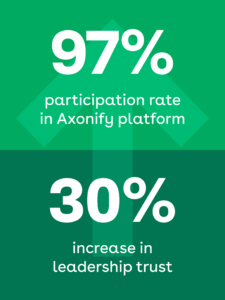Frontline Learning Guide
A comprehensive roadmap for frontline learning
Chapter 3
- Introduction
- Chapter 1: Top barriers to frontline success (and solutions from real-life L&D leaders)
- Chapter 2: 4 key capabilities to empower your frontline
- Chapter 3: How to make learning simple for your frontline
- Chapter 4: 4 steps to make learning valuable for your frontline
- Chapter 5: 4 ways to go beyond digital learning
- Chapter 6: 5 tools to motivate frontline workers to come back for training
How to make learning simple for your frontline
Making it easy to access learning activities is the first step to creating a frictionless learning experience for frontline workers, who have limited time and unique challenges. If it takes employees several clicks to get to a learning module, it’s likely they’ll never get to it. Instead, make learning an everyday habit
Here are 5 practical ways to simplify learning:
1. Boost learning equity by applying accessibility standards, including language and reading level
To make learning an everyday habit for frontline employees, it must be easily accessible and fit seamlessly into their daily routines, like clocking in or attending a pre-shift huddle. Accessibility is the foundation of a frictionless learning experience—one that goes beyond meeting compliance standards. It’s about ensuring that everyone, regardless of language preference or reading ability, can access and understand the information they need.
Advancements in technology, including AI-powered translation and automated captioning, allow us to remove barriers and make learning equitable for all. By simplifying the learning experience you enable frontline workers to focus on gaining knowledge, not just on trying to comprehend it.
2. Use common credentials, such as single sign-on and swipe access
Ease of access is essential for engaging frontline workers in learning. While single sign-on (SSO) is often the go-to solution, you can simplify access even further by aligning login methods with the tools employees already use on the job. Think beyond SSO—consider options like common usernames and passwords, or even swipe access with employee ID cards.
Matching the learning platform’s login experience with other everyday work systems eliminates friction and confusion. For example, if workers can swipe their ID to access a point-of-sale system, they should be able to use the same method for training. This seamless access reduces the need to remember multiple credentials, saves time and removes the burden on managers who often have to help employees navigate login issues.
The goal is simple: make learning as effortless as the tools they already use.
3. Apply schedule awareness so people always know what they can/cannot do
For frontline workers, who are often paid hourly, maintaining a clear boundary between work and personal time is crucial. This extends to their training: if they’re not clocked in, they may not have access to work—including learning. Traditionally, the solution has been to lock employees out of the LMS when they’re off the clock, but this approach can limit the platform’s value.
Schedule-aware learning platforms can adapt to an employee’s shift status, allowing access to essential information without compromising labor policies. Instead of a blanket lockout, these systems can turn specific features on or off based on whether a worker is clocked in. For example, training activities might be restricted during off-hours, but employees could still receive important company updates, access HR information or stay connected with their managers.
This balance between accessibility and compliance not only respects the nature of hourly work but also keeps frontline teams informed and engaged, even when they’re away from the job.
4. Design a consumer-grade experience that looks and feels familiar
Most people are primed by digital experiences that are seamless, engaging and intuitive—think YouTube, TikTok or Instagram. But learning management systems often fall short of this standard, making training feel like an uphill battle. To truly connect with frontline teams, your learning platform should mimic the consumer-grade experiences they encounter every day, where no instruction manual is needed, and every interaction feels natural.
One simple yet powerful example is Axonify’s “Start” button. When employees log in, they press one button and the platform takes over, delivering a personalized, directed experience tailored to their needs for that day. This user-friendly design recognizes that frontline employees don’t have the luxury of time to browse through a complex curriculum—they need quick, targeted learning that fits into their workflow.
By prioritizing a familiar, consumer-like experience, companies can reduce the friction that often comes with traditional training platforms. It’s not just about making the tech look good; it’s about removing the barriers that prevent employees from engaging with the learning content in the first place.
5. Direct employees to the most high-value learning activities

Frontline workers have minutes—if not seconds—to spare, so directing them to the most relevant learning activities is crucial. Instead of overwhelming employees with a sea of options, a directed learning experience can guide them straight to what matters most.
This approach balances the push and pull of digital training: employees get the immediate, directed training they need, and they can explore recommendations and browse content only after fulfilling core learning objectives.
This strategy isn’t about eliminating choice; it’s about making every minute count. Southeastern Grocers, with 45,000 frontline workers across seven states, has maintained a remarkable 97% training engagement rate over a decade. By making learning accessible and focused, employees routinely engage two to three times per month—not because they’re forced to, but because it fits effortlessly into their daily routine.
Directed learning is more than just saving time—it’s about training with purpose. By focusing on the most impactful activities, companies can reduce overall training time, targeting only the skills and knowledge that directly enhance job performance. It’s not about training for the sake of training; it’s about maximizing the time that’s available.
TIP: Make it as simple as possible for people to engage in learning activities so you can focus on motivation and value, rather than overcoming basic obstacles to access.